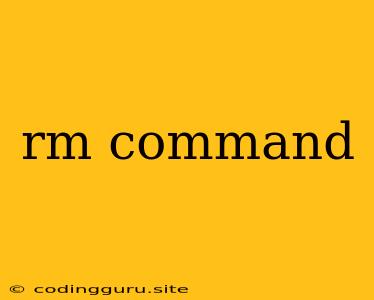Understanding the rm Command: A Comprehensive Guide to File Removal in Linux
The rm command is a powerful and essential tool in the Linux command-line environment. It allows you to delete files and directories efficiently. Understanding how to use rm correctly is crucial, as deleting files permanently without proper precautions can lead to data loss. This guide will delve into the intricacies of the rm command, equipping you with the knowledge to safely and effectively manage your files.
What does rm stand for?
rm is a short form of "remove", which perfectly reflects its primary function. It's a basic yet powerful command that offers a multitude of options for file removal.
How to Use the rm Command
The basic syntax of the rm command is:
rm [OPTIONS] [FILE]...
Here, [OPTIONS] represent various flags that modify the behavior of the command, and [FILE] refers to the file or directory you want to remove. Let's break down some of the most commonly used options:
-i (Interactive mode): This option prompts you for confirmation before deleting each file. This is highly recommended for sensitive files or directories.
rm -i file.txt
This will ask you "rm: remove file.txt? y/n" before deleting the file.
-f (Force): This option bypasses any prompts and forcibly removes the file or directory. It is helpful when dealing with read-only files or directories.
rm -f file.txt
-r (Recursive): This option allows you to recursively remove directories and their contents. Use this with caution, as it will delete everything within the directory, including subdirectories.
rm -r directory_name
-v (Verbose): This option displays the names of the files being deleted. This is useful for confirming which files are being removed.
rm -v file.txt
-d (Directory): This option allows you to remove empty directories. This is similar to rmdir but provides the ability to remove a directory within a larger command.
rm -d directory_name
-R (Recursive): This option is an alias for -r.
Example:
rm -r -i /home/user/Downloads/*
This command will prompt you to confirm the deletion of all files and subdirectories within the /home/user/Downloads/ directory.
Safety Precautions with rm
- Always double-check the path and file name before executing
rm. Mistyping can lead to the deletion of unintended files. - Use the
-ioption whenever possible. This will prompt you for confirmation before deleting any files. - Avoid using the
rmcommand on sensitive directories like/etcor/var. Deleting files in these directories can render your system unusable. - Consider using
mvfor moving files instead of deleting them. This way, you can always restore them from their new location.
Alternatives to rm
While rm is the primary tool for removing files, there are alternative methods depending on your needs:
rmdir: This command is specifically used for removing empty directories.trash-cli: This command allows you to move files to the Trash directory instead of permanently deleting them. This offers an additional safety measure for accidental deletions.srm: This is a secure deletion command that overwrites files with random data to prevent recovery using specialized tools.
When You Need to Recover Deleted Files
It is possible to recover accidentally deleted files in some cases. However, recovery success depends on factors such as:
- The type of file system: Some file systems are more resistant to data loss than others.
- Whether the file was overwritten: Once data is overwritten, recovery becomes much more difficult, if not impossible.
- The tools used for recovery: Specialized data recovery tools might be necessary.
Remember that the best approach for preventing data loss is to exercise caution when using rm and to make backups of essential files.
Conclusion
The rm command is an integral part of the Linux command-line experience. By understanding its options and usage, you can efficiently manage your files and avoid accidental data loss. Always remember to double-check the path and file name before execution, and use the -i option for confirmation whenever possible. While rm is a powerful tool, it's also important to be aware of its potential risks and to use it responsibly.
